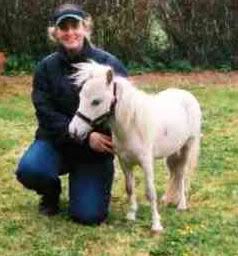Pictorial Guide to Horse Colors Part 5
This guide is written to help identify horse colors. It does not explain the genetics behind the colors. If you would like to know more about the genetics of these colors please visit Dilutions in horses. If you would like to view more examples of Silver horses please visit the Silver Gallery.
Silver in Horses
Silver in horses affects areas that would otherwise be black, changing the color from black to gray or brown. It has it’s greatest effect on a horse’s mane and tail. In horses that are heavily affected the mane and tail can be almost completely white or silver. If the horse also has feathers (the hairs on the horse's pastern), the feathers will be affected to the same extent as the mane and tail. Because silver only affects black pigment, Chestnut horses and the red body of Silver Bays will not be changed.
Silver can at times be difficult to recognize however, silver foals are often born with very light or white eyelashes and flaxen manes and tails. Silver can cause striped hooves and mottled skin although these characteristics are not universal. The expression of silver can vary drastically across breeds and individual animals. Generally it is highly expressed in breeds such as the Rocky Mountain horse, Miniatures, and Gypsy Horses. It tends to express minimally in stock horse breeds such as Quarter Horses, American Paint horses and Appaloosas. Some horses of the stock horse breeds who have tested positive for silver look more like they have a sun bleached mane than the typical silver mane and tail expression we see in other breeds. (Silver is still a rarity in the stock horse breeds however, so unless your horse is descended from known silver lines don’t hopefully think your horse is silver just because it has a bleached mane and tail.)
Silver is associated with eye problems. Although the vast majority of silver horses are not affected, it is best to be aware of the association so that proper vet checks can be conducted before purchase.
Silver is sometimes referred to as Silver Dapple because it often (but not always) is present with heavy dappling. Other terms used in association with silver are Chocolate and Taffy. The use of the term Chocolate is the most common among Gaited breeds in the Eastern United States while Taffy is often used in Australia.Silver Bay
Silver Bay horses will have brown or gray points (at times barely visible) and a mane and tail that can vary from bleached looking to completely white. Many times silver bay horses are mistaken for flaxen chestnut, especially as foals. Silver bay foals rarely have leg points therefore, pedigree and white eyelashes are clues to distinguishing silver bay from flaxen chestnut foals

A rare silver bay Gypsy Cob colt. He has been color tested as EE Aa nZ - homozygous black, heterozygous bay, and heterozygous silver. Photo courtesy of Vines Gypsy Horses
Silver Brown
Silver brown horses will be similar to silver bay but darker with more brown or gray coloration on the body. Some of the darkest may look Silver Black but have reddish noses and flanks.
Silver Black
A silver black will be a fairly uniform gray or brown with a mane and tail that can vary from a bleached appearance to completely silver or white. Some silver blacks go through amazing color changes. Some will be so extreme as to look palomino in their faded foal coats only to shed off a more normal silver black color. To see more on this color change visit Silver Fox Album.
Silver Chestnut
Silver Chestnut is not technically a color as silver does not modify chestnut. It is used rather to designate a chestnut horse who also carries the silver gene.
Gray Silver
It is interesting to note that when gray and silver are both present the affected horse will gray very rapidly. They are often completely white by the time they are yearlings and their have been reports of grays with silver being born completely white (as caused by gray not a white pattern).

Chywoon Rusty's Applause 28" AMHA stallion, Silver Black Tobiano with gray as a yearling. An example of how fast a silver with gray will gray.











